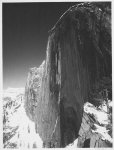The Histogram is important in relating these various exposures to each other. All the styles do is work as a preset to get certain effects without manually changing ISO and shutter speed. If you watch the histogram and record the changes in ISO and shutter speed when changing styles you will get a pretty good idea of what they do. I don't use them much at all.
As you can see, when the peaks in the histogram are more or less in the middle the exposure is close to correct for that subject, in this case green and yellow vegetation. If you were taking a picture of snow, you would want the peaks to be most of the way to the right. It's a bit easier to see with a decent digital camera because you can use the zoom to isolate certain areas. Back in my aerial photography days I used a grey card a lot. That let me set the exposure so that the grey card actually showed up as grey in the middle of the histogram (which didn't exist back then) But if grey was gray, then white was white and black was black in the print. Fine for bright sun, but if you wanted detail in darker areas you had to increase the exposure and let any whites get overexposed. Generally, in vertical aerials, the ground was similar in value to a grey card and I almost always used the same speed and aperture time after time. Film speed (ISO) was fixed at 100 for 99% of the few film types I used. This holds pretty much true for drone verticals too. If the result is too bright, set -1 EV, if it is too dark, set +1 EV and let the camera do the rest. Being able to preview before shutting down is great for that!
Since we don't have a variable aperture, we can only set ISO and shutter speed to get what we want. Setting a 1 stop lower EV value is the same as doubling the shutter speed....which is also 1 stop lower exposure value. This is why I use EV compensation most of the time: it is faster, simpler, and more accurate than changing shutter speed and ISO. I only have to look at one place on the screen, poke it, and then poke the +1 or - 1. Rarely would I go beyond 1....snow might need +2. If I was wandering through a deep forest and wanted to make it look creepy I might go as far as -2.
The human eye has a far greater ability to see brighter whites and darker blacks simultaneously than any camera ever made, so when shooting hi contrast subjects, you have to choose which part of the subject you want to be exposed to which value....most of the time that is the middle values....trees, flowers, skin, etc. but if it is beach sand or snow you would want it bright, which would underexpose everything else.
Your eye is a pretty good judge of exposure value, since you have seen millions of correctly exposed photos in your life. It's easy to get all wrapped up in the technicalities, but remembering just three things will get you better drone photos and video: Bright subjects should appear bright, dark subjects should appear dark, and if you want moving subjects to look like every movie shot you have ever seen use an ISO of 100 and a shutter speed of 1/50. If your subject is not moving you can shoot at any speed. You still have to decide if the footage is too bright or too dark and compensate with EV.





